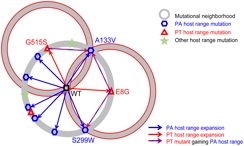
Experimental evolution of emerging viruses To infect a novel host, viruses usually need to evolve. Most viruses require a host range mutation to enter a novel host. Once able to enter, they fix additional mutations to adapt to the novel host, and to increase their transmission between hosts. While the exact mutations that are beneficial for a particular virus on a particular host are highly individual and dependent on the virus’ ecology, there may be general properties of adaptive mutations in emerging viruses that we can study in model systems. For instance, RNA viruses seem much more likely than DNA viruses to host-shift into humans -- is this because host range mutations have a lower cost in RNA viruses? Or is it because RNA viruses have higher mutation rates, and therefore more frequently sample host range mutations? Is it simply because there are many RNA viruses infecting other mammals, and it is easier for viruses to host-shift between closely related hosts?
We use experimental evolution to simulate viral emergence events on novel hosts. This allows us to study the frequency and effects of adaptive mutations in a wide variety of viruses (RNA and DNA, single- and double-stranded, segmented and monopartite). Longer evolution experiments also allow us to study the adaptive walks of these viruses as they adapt to a novel host.
Understanding viral genetic variation
As natural selection can only act on variation within a population, we also study the mechanisms by which viruses create and maintain variation: mutation, recombination, reassortment. This work spans the gamut from field work to molecular microbial genetics, and often relies on intensive sequencing of viral populations. Currently, we are focused on understanding how epistasis shapes diversity and evolutionary trajectories in RNA viruses.
What are the downsides to having a host range mutation?
Using a couple of bacteriophage phi6 host range mutants (that can now infect host P. syringae pv tomato), we tested how having one host range mutation affected viruses obtaining new spontaneous host range mutations to infect another novel host, P. syringae pv atrofaciens. We found that a wildtype phi6 can have any of at least 14 different point mutations that allow infection of P. syringae pv atrofaciens, but the strains that already have a host range mutation have only one or two possible host range mutations to the same host. There is significant epistatic constraint of having one host range mutation on acquiring another one (Duffy et al. 2019).

